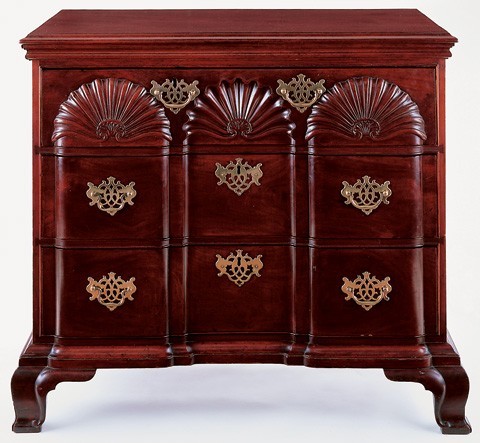
Chest of drawers attributed to Job Townsend, Jr., Newport, Rhode Island, 1760–1770. Mahogany with white pine, chestnut, and tulip poplar. H. 32", W. 35 3/4", D. 20 1/2". (Private collection; photo, Gavin Ashworth.)

Detail of the signature on the chest illustrated in fig. 1. (Courtesy, Christie’s.)

Entry for Katherine Gould in Job Townsend, Jr.’s, daybook, July 17, 1763, p. 77. (Courtesy, Newport Historical Society; photo, Gavin Ashworth.)
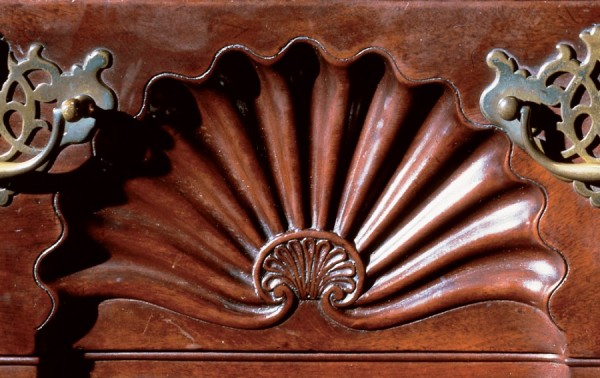
Detail of a carved shell on the chest illustrated in fig. 1. (Photo, Gavin Ashworth.)
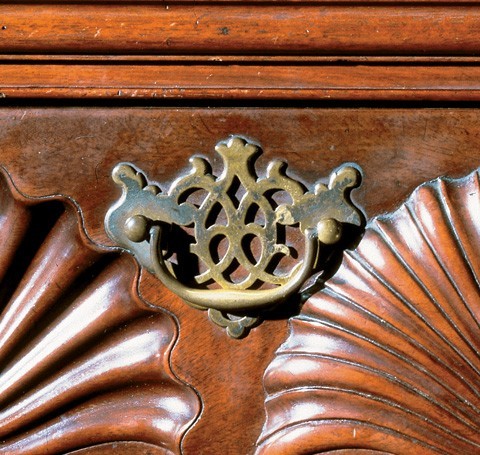
Detail of a brass pull on the chest illustrated in fig. 1. (Photo, Gavin Ashworth.)
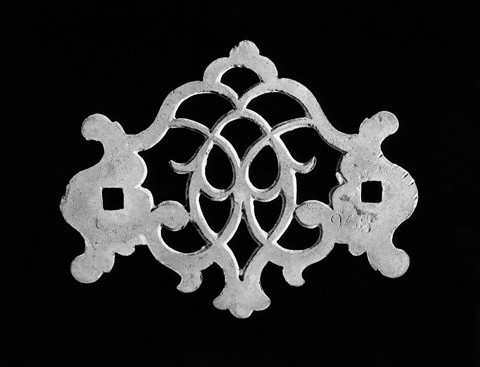
Detail of the back of the brass pull illustrated in fig. 5. (Photo, Gavin Ashworth.)

Desk attributed to Job Townsend, Jr., Newport, Rhode Island. Maple and mahogany with white pine, chestnut, and tulip poplar. H. 40 7/8", W. 38 5/8", D. 21 1/2". (Courtesy, Milwaukee Art Museum; gift of Mrs. William D. Hoard, Jr.)
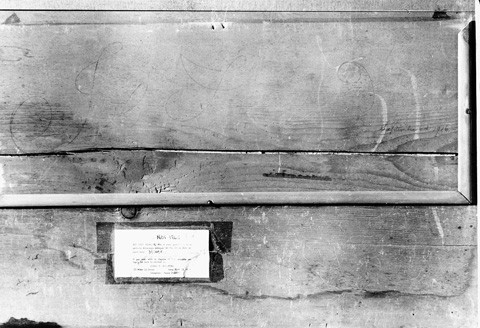
Detail of the signature on the desk illustrated in fig. 7.
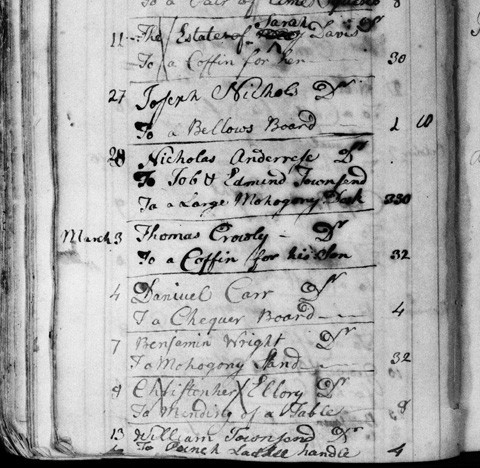
Entry for Nicholas Anderrese in Job Townsend, Jr.’s, daybook, February, 28, 1767, p. 96. (Courtesy, Newport Historical Society; photo, Gavin Ashworth.) The entry indicates that Job, Jr., and Edmund Townsend collaborated on Anderrese’s desk.
An account book in the collection of the Newport Historical Society offers a wealth of information on the business activities of two cabinetmakers working during the late eighteenth and early nineteenth centuries. Written in two distinct hands, the accounts include the ledgers and daybooks kept by Job Townsend, Jr. (1726–1778), and his son, Job E. Townsend (1758–1829). This essay and the following transcription (appendix 1) examines the accounts kept by the elder cabinetmaker covering the years from 1750 to his death in 1778.[1]
Born into the celebrated Townsend-Goddard family of cabinetmakers, Job Townsend, Jr., and over eighteen of his relatives through kinship or marriage produced an array of furniture in the late baroque, rococo, and neoclassical styles. Best known for their blockfront, shell-carved furniture, the Townsends and Goddards dominated the furniture industry in colonial Newport. Job, Jr., undoubtedly trained under his father, Job, Sr. (1699–1765). In 1750, the year the account books begin, he completed his training and began working on his own. He married Deborah Taylor three years later, and his son, Job E. Townsend, was born in 1758. Upon Job, Sr.’s, death in 1765, Job, Jr., inherited his father’s shop on Bridge Street. Located on Easton Point just north of the wharves, the shop was in the epicenter of eighteenth-century Newport’s furniture-making community and just two blocks away from the shop of Christopher Townsend (1701–1787), Job, Jr.’s, uncle. The tax rolls of 1767, 1772, and 1777 indicate that his financial success was moderate. Compared to three family members of his own generation—his cousin John (1732–1809), younger brother, Edmund (1736–1811), and brother-in-law, John Goddard (1723–1785)—he paid significantly lower taxes, and his estate was left unrecorded; nevertheless, there are signs that he enjoyed a measure of prosperity. With John Goddard, he served as Viewer of Lumber, a post previously held by his father, and according to the Newport census of 1774, Job Townsend, Jr.’s, household included an African-American, probably a slave.[2]
During the time Job, Jr., kept his accounts, Newport was a major center of economic activity, second only to Boston in New England. Located at the mouth of the Narragansett Bay, Newport was ideally situated for the mercantile pursuits of entrepreneurs in the shipping business. Furthermore, Newport’s particular social traditions fostered free trade. Jeanne Vibert Sloane argues that Rhode Island’s religious tolerance contributed to the establishment of a “laissez-faire” economy that contrasted with the restrictions placed on trade in Calvinistic Boston. In this setting, merchants such as Charles Champlin, Aaron Lopez, and Joseph Gardner amassed substantial fortunes through the triangular trade of rum, slaves, and molasses from New England to the African coast and back via the Caribbean. Such prosperity provided numerous artisans with large local and export markets for their wares. From 1745 to 1775, Newport supported at least sixty cabinetmakers, whereas Boston supported at least sixty-four. When each city’s population is taken into account (in 1755 Newport had 6,753 citizens compared with over 15,000 in Boston), such a large number of cabinetmakers attests to the vitality of Newport’s artisan community.[3]
In this milieu, Job Townsend, Jr., concentrated on making furniture for local use, and his recorded activities reveal the transactions of an urban craftsman who maximized his income through product specialization rather than diversification. Although the accounts cannot be considered a complete record of either output or income, the recorded transactions can be used to illustrate general patterns of Job, Jr.’s, business activities. During the years 1762 to 1776, furniture production accounted for 69 percent of his total credit income (see table 1). This percentage is higher during his more prosperous years in the early 1760s. In 1763, his most financially successful year, 84 percent of his credit income derived from newly made furniture (see table 2). As Job, Jr.’s, output, and possibly his recordkeeping skills, dwindled during his later years, furniture making still remained his most lucrative occupation. Coffins were Job, Jr.’s, second greatest source of credit income. Never more than a quarter of his credit income in any given year, coffins accounted for 17 percent of his total credit income from 1762 to 1776 (see tables 1, 2). The remaining activities noted in the account books consist of mending furniture, performing miscellaneous joinery, making and mending tools, and bartering goods, all of which accounted for 14 percent of the total income recorded during the same years. The account books kept by rural joiners illustrate very different strategies required to maximize income in primarily agricultural settings. Using the accounts of woodworkers working in the late eighteenth and early nineteenth centuries, Philip Zea demonstrates that, without a large market for any single product or services, rural joiners had to be versatile and to respond to a variety of needs largely determined by seasonal changes. Zea calculates that only about a quarter of their income came from making furniture, despite their ability to create high-quality furniture.[4]
| Table 1 |
The Credit Income of Job Townsend, Jr., as Recorded in the Daybook, 1762–1776 | |
|
Credit Income in £
|
Percentage of Total
|
|
| Furniture |
12,469.10.6
|
69
|
| Coffins |
3,075.0.0
|
17
|
| Repairs, services, and miscellaneous joinery |
1319.7.6
|
7
|
| Tool production and repairs |
598.9.0
|
3.3
|
| Barter goods |
411.7.0
|
2.2
|
| Other |
284.0.0
|
1.5
|
| Total |
18,157.14.0
|
100
|
| Table 3. |
The Credit Income Derived from Furniture of Job Townsend, Jr., as Recorded in the Daybook, 1762–1776 | |
|
Credit Income in £
|
Percentage of Total
|
|
| Tables |
6,581.10.0
|
53
|
| Desks |
2,483.0.0
|
20
|
| Tea Boards |
825.0.0
|
6.6
|
| Chairs and seating furniture |
601.10.0
|
4.8
|
| Cases of Drawers |
590.0.0
|
4.7
|
| Bedsteads |
404.4.6
|
3.2
|
| Chests |
255.0.0
|
2
|
| Bottle stands |
240.10.0
|
1.9
|
| Boxes |
155.10.0
|
1.2
|
| Other |
333.6.0
|
2.6
|
| Total |
12,469.10.6
|
100
|
|
* All figures have been rounded to the nearest pound
|
||
Job Townsend, Jr., concentrated his production on a few furniture forms. During his most lucrative years, 1762 to 1776, tables and desks accounted for 73 percent of his credit income derived from furniture (see table 3). Made in the largest quantities, tables were the single greatest source, with 149 examples accounting for 53 percent of his credit income. Most of the tables are described by their primary wood, size, and function. Made of either mahogany or maple, they include fly, stand, tea, kitchen, twilight, breakfast, frame, dressing, and backgammon tables. The seventeen desks that Job, Jr., made during the same period accounted for 20 percent of his furniture credit income. For this form, the descriptions specify wood use and, like the tables, the desks were either of mahogany or maple. Another 19 percent of Job, Jr.’s, furniture credit income came from tea boards, cases of drawers, chairs, and bedsteads. Revealing standardized practices, tea boards were made in large numbers and priced, according to his own list on the front page of his account book, by size. Comparable in price to desks, cases of drawers are rarely mentioned and comprise only three examples: one made of mahogany, one made of maple, and a “Neast of drawers.” The remainder of the furniture forms include chests, cradles, firescreens, a variety of boxes, bottle stands, and unusual items such as a quadrant case, bird cage, and checker board.[5]
The accounts of Job Townsend, Jr., indicate that he made several expensive forms. Although the number of references to furniture in the ledger is far fewer than the number recorded in the daybook, Job Townsend, Jr., made a greater number of expensive forms during his earlier years. Since these were among his least lucrative years, it appears that the production of ornate, labor-intensive forms was less profitable than the production of cheaper objects that could be sold to the middle market or as venture cargo.[6]
Only two surviving forms can be tentatively attributed to Job Townsend, Jr. A blockfront chest with carved shells has a faint chalk signature on its bottom drawer that appears to contain the same distinctive scooped “J” seen in the account books and in the signature on the desk discussed below (figs. 1, 2). This chest may be the “mahogany case of drawers” debited to Katherine Gould on July 17, 1763 (fig. 3). Priced at £315, it is the only mahogany case of drawers listed in the daybook and the second most expensive item listed in the account books. The carved shells (fig. 4) and pierced brass pulls (figs. 5, 6) and escutcheon plates were options available on the most expensive Newport furniture. Similar brasses occur on contemporary pieces made by other Newport cabinetmakers. Some are numbered like the pulls and escutcheon plates on the Townsend chest. These numbers probably refer to brass patterns illustrated in Birmingham trade catalogues.
The second piece attributed to Job, Jr., is a signed slant-front desk (fig. 7). Though previously attributed to his father, the desk’s graphite signature (fig. 8) also closely resembles the handwriting in Job, Jr.’s, accounts. Unusual in its combination of two primary woods, the desk has a carved mahogany interior and a maple case, fallboard, and drawer fronts. In 1763, Job, Jr., charged John Warren £18 for “staining of a desk.” The use of stained maple as a cheap alternative to mahogany was relatively widespread in eighteenth-century New England. In 1763, Job, Jr., charged approximately £75 for a maple desk and over £240 for a mahogany example.[7]
With many specific references to woods and craft skills, the account books further describe the priorities, capabilities, and limitations of Job Townsend, Jr.’s, shop. As mentioned above, he used either maple or mahogany as the primary wood for the vast majority of his furniture. Although size and degree of decoration also accounted for price differentials, maple tables and desks were generally one-third to one-half the cost of the same forms made of mahogany. There are only five references to other primary woods—a pine desk, a red cedar desk, six black walnut chairs, a black walnut close stool, and a red cedar dressing table. For his secondary woods, Job Townsend, Jr., presumably chose from the chestnut, poplar, cedar, and pine boards he bought in stock. Demonstrating the high rate of infant mortality, the listing of coffins usually only describes the deceased; however, when the wood is specified, they were made of red cedar and, for the more expensive examples, mahogany and black walnut. Unfortunately for furniture historians, decorative details are rarely specified. One reference indicates that Job, Jr., was capable of carving; in 1762 he made a bedstead “with claw feet.” He was also a turner. There are several references to turning balls for architectural elements, billiard balls, legs, and bed posts.
Although some of these debits were simply itemized listings for a form completed by Job Townsend, Jr., others indicate that he occasionally produced and sold parts to other cabinetmakers such as Gideon Lawton and David Huntington. With relatively few credits listed in the daybook, it is impossible to determine if Job Townsend, Jr., received ready-made parts; however, the ledger includes a credit from cabinetmaker Constant Bailey for a set of maple legs, thus raising the possibility that Job, Jr., commissioned others to supplement his work on an occasional basis. The account books reveal no information regarding Job, Jr.’s, employment of apprentices or journeymen. Since his only son, Job E. Townsend (1758–1829), became a cabinetmaker and recorded his own accounts in the same journal kept by his father, it is highly likely that the son trained in his father’s shop after about 1768. The single reference to a collaborative commission (fig. 9)—with his brother and fellow cabinetmaker, Edmund Townsend—indicates that Job, Jr., rarely worked with others.
With each debit citing the name of the purchaser, the account books provide considerable information regarding Job Townsend, Jr.’s, clientele. Among those debited are the most prominent shipping merchants of colonial Newport such as Stephen Ayrault, Charles Cozzens, Aaron Lopez, Jonathan Remington, John Wanton, and Governor Joseph Wanton. Although these individuals and others commissioned furniture for the export trade, evidence in the account books suggests that the majority of Job Townsend, Jr.’s, wares were made for local use. In contrast to the accounts of John Cahoone, Job, Jr.’s, books rarely list large quantities of furniture in a single debit and never specifically refer to furniture consignments on shipping ventures. Entries clearly indicative of the export trade include red cedar and maple forms made with cases, including a red cedar dressing table to “Thomas George of Jamica,” tea boards and bottle stands made in volume, and debits to shipping companies. Even considering the probability that several other entries indistinguishable from those referring to locally used products may also include furniture made for export, Job Townsend, Jr.’s, reliance on the export trade was minimal. Studies have shown that the forms most frequently exported from Rhode Island in the eighteenth century were desks and secretaries, and unlike John Cahoone who specialized in these forms, Job, Jr., made considerably more tables. Job, Jr.’s, clients also included a number of Newport joiners and cabinetmakers. For these craftsmen, he supplied lumber, bartered goods and tools, and provided services such as turning and repairing tools. The accounts also detail the form of payment for products and services rendered by Job Townsend, Jr. They largely consist of cash payments, furniture hardware, lumber, bartered goods, and orders placed by a third party’s shop.[8]
Recorded by his son in the account book, Job Townsend, Jr.’s, death coincided with the British occupation of Newport and the end of the city’s era of prosperity during the eighteenth century. Evidence from the account books points to the enormous impact of the arrival of the British upon Newport’s economy. Job Townsend, Jr.’s, only reference to events beyond the day-to-day activities of his own shop occurs in 1776 with, “December ye 6 the Brrithish Troops Landded at Newport,” and the transactions recorded in 1777 and 1778 reveal a significant decline in output and credit income. At the same time, his own ill health may have contributed to a decline in business. Dated April 7, 1778, his final entry is followed by his son’s notation, “Job Townsend Died/ November the 5 AD 1778/ at 10 Clock in the morning.”
Appendix 1
Job Townsend, Jr., Ledger/Daybook, 1750–1793, Newport Historical Society, Newport, Rhode Island, vol. 504. Although the handwriting of father and son is very similar, distinctions between certain capitalized letters, notably “A” and “M,” determine its author’s hand. Michael Moses has contended that the ledger from 1750 to 1760 represents that of Job Townsend, Sr., whereas Jeanne Vibert Sloane and others have attributed these entries to Job Townsend, Jr. As the handwriting of 1750 to 1760 is identical to that of later entries, including those written after 1765, the year Job Townsend, Sr., died, the latter interpretation is accepted here. See Michael Moses, Master Craftsmen of Newport: The Townsends and Goddards (Tenafly, N.J.: MMI Americana Press, 1984), p. 248; and Jeanne Vibert Sloane, “John Cahoone and the Newport Furniture Industry,” in New England Furniture: Essays in Memory of Benno Forman, edited by Brock Jobe (Boston: Society for the Preservation of New England Antiquities, 1987), p.120, nt. 19.
For more on Job Townsend, Jr., and, Sr., see Ralph E. Carpenter, Jr., The Arts and Crafts of Newport, Rhode Island 1640–1820 (Newport: Preservation Society of Newport County, 1954), pp. 10–12, 15–16; and Moses, Master Craftsmen of Newport, pp. 247–51. See also Mabel M. Swan, “The Goddard and Townsend Joiners: Part I,” Antiques 49, no. 4 (April 1946): 228–31; Wendell B. Garrett, “The Newport Cabinetmakers: A Corrected Checklist,” Antiques 73, no. 6 (June 1958): 558–561; Wendell B. Garrett, “The Goddard and Townsend Joiners: Random Biographical Notes,” Antiques 94, no. 3 (September 1968): 391–93; and Wendell B. Garrett, “The Goddard and Townsend Joiners of Newport: Random Biographical and Bibliographical Notes,” Antiques 121, no. 5 (May 1982): 1153–55. The tax rolls of 1767 list Job, Jr., and John Goddard with no ratables, whereas John had £105 and Edmund had £34; in 1772, Job, Jr., paid 2s, John paid £2.1, Edmund paid 14s and John Goddard paid 17s; in 1775, Job, Jr., paid 1s 6d, John paid £1.7.7, Edmund paid 9s 3d, and John Goddard paid 11s 6d (Moses, Master Craftsmen of Newport, Appendix A-3, p. 345).
Sloane, “John Cahoone and the Newport Furniture Industry,” pp. 89, 91.
Philip Zea, “Rural Craftsmen and Design,” in New England Furniture: The Colonial Era, edited by Brock Jobe and Myrna Kaye (Boston: Houghton Mifflin Company, 1984), pp. 56–63. The accounts of other cabinetmakers working in both urban and rural settings provide useful comparisons to those of Job Townsend, Jr. Sloane’s study of the accounts of John Cahoone, another Newport cabinetmaker working in the 1750s, shows that Cahoone also concentrated on furniture production, though participating more actively than Job Townsend, Jr., in the export trade and bartering goods. See Sloane, “John Cahoone and the Newport Furniture Industry,” pp. 88–122 and for her tabulation of Cahoone’s work, see Jobe and Kaye, New England Furniture, p. 15, fig. I-7. See also Charles F. Hummel, “The Dominys of East Hampton, Long Island and Their Furniture,” and Charles S. Parsons, “The Dunlaps of New Hampshire and Their Furniture,” both in Country Cabinetwork and Simple City Furniture, edited by John D. Morse (Charlottesville: University Press of Virginia, 1970), pp. 34–150.
The accounts listed in the ledger and covering the years 1750 to 1759 show that Job Townsend, Jr., did not concentrate on table production to the same degree as he did during the later years. With a total of £2864 of income derived from furniture during these years, the percentages for each form are as follows: tables 36 percent, desks 37 percent, cases of drawers 22 percent, tea boards 2 percent, other 3 percent. For a listing of forms produced each year, see Moses, Master Craftsmen of Newport, Appendix A-6, pp. 346–49.
During the 1750s, Job, Jr., made seven mahogany desks valued from £70 to £105 each, a red cedar desk and case valued at £82, four mahogany cases of drawers valued from £75 to £95 each, an unspecified case of drawers valued at £105, a mahogany high case of drawers valued at £90, and four tables valued from £60 to £75 each. Over the fourteen-year period from 1762 to 1776, he made only eight forms valued £200 or higher: six mahogany desks, a mahogany case of drawers, and the nest of drawers mentioned above, also probably made of mahogany.
For a previous discussion on the signed slant-front desk, see American Furniture with Related Decorative Arts, 1660–1830, The Milwaukee Art Museum and the Layton Art Collection, edited by Gerald W. R. Ward (New York: Hudson Hills Press, 1991), p. 46; and Moses, Master Craftsmen of Newport, p. 267. With the change of currency rates in Rhode Island after 1763 accounting for some of the price differential, maple desks were valued lower during the 1750s, and in the ledger are priced between £30 and £56. The case of drawers made for Katherine Gould appears on p. 77 of the daybook and is second only to a large mahogany desk priced at £330 and made by Job Townsend, Jr., in conjunction with his brother, Edmund, for Nicholas Anderrese in 1767, listed on p. 96. For more on the chest-of-drawers, see Christie’s, Important American Furniture, Silver, Prints, Folk Art and Decorative Arts, New York, January 15–16, 1999, pp.140–45, lot 694.
For a listing of all clients recorded in the ledger, see Moses, Master Craftsmen of Newport, Appendix A-10, pp. 354–55. For entries pertaining to the export trade, see Job Townsend, Jr.’s, ledger, pp. 18, 20; and daybook, pp. 71, 73, 80, 87, 94, 96, 99, 104, 110. For details on John Cahoone’s export production, see Sloane, “John Cahoone and the Newport Furniture Industry,” pp. 93, 94. For information regarding the export trade in the late eighteenth century, see Joseph K. Ott, “Rhode Island Furniture Exports, 1783–1800,” Rhode Island History 36, no. 1 (February 1977): 3–13. The ledger provides more details regarding payment, with a client’s credits listed next to the debits, whereas the daybook includes far fewer credits but with several debit entries marked with an “X” indicating that payment was recorded but not specified.
